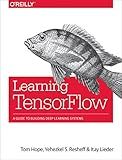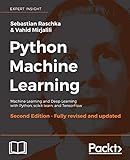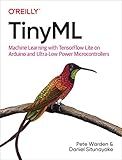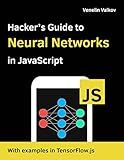Best TensorFlow Guidebooks to Buy in December 2025

Learning TensorFlow: A Guide to Building Deep Learning Systems



Practical Deep Learning for Cloud, Mobile, and Edge: Real-World AI & Computer-Vision Projects Using Python, Keras & TensorFlow



Hands-On Machine Learning with TensorFlow.js: A guide to building ML applications integrated with web technology using the TensorFlow.js library



Intelligent Mobile Projects with TensorFlow: Build 10+ Artificial Intelligence apps using TensorFlow Mobile and Lite for iOS, Android, and Raspberry Pi



Python Machine Learning - Second Edition: Machine Learning and Deep Learning with Python, scikit-learn, and TensorFlow



R Deep Learning Essentials: A step-by-step guide to building deep learning models using TensorFlow, Keras, and MXNet, 2nd Edition



TinyML: Machine Learning with TensorFlow Lite on Arduino and Ultra-Low-Power Microcontrollers



The Mostly Mathless Guide to TensorFlow Machine Learning



Hacker's Guide to Neural Networks in JavaScript: Beginners Guide to Understanding Machine Learning with TensorFlow.js in the Browser and Node.JS (Deep Learning)


To load a list of dataframes in TensorFlow, you can first convert each dataframe to a TensorFlow dataset using the tf.data.Dataset.from_tensor_slices() method. This method takes the DataFrame as input and converts it to a dataset of tensors.
You can then combine these datasets into a single dataset using the tf.data.Dataset.concatenate() method. This allows you to create a single dataset containing all the data from the list of dataframes.
Finally, you can iterate over the combined dataset to access the individual elements of each dataframe. This allows you to efficiently load and process a list of dataframes in TensorFlow for further analysis or modeling.
What is the process of reshaping dataframes for TensorFlow models?
Reshaping dataframes for TensorFlow models involves transforming the data into the appropriate format that can be fed into the neural network model. This typically involves the following steps:
- Extract the input features and target variable from the dataframe.
- Normalize or standardize the input features to ensure they are on a similar scale.
- Convert the input features and target variable into numpy arrays using the .values method.
- Reshape the input features and target variable arrays to the desired shape using the .reshape method.
- Split the data into training and testing sets using sklearn's train_test_split function.
- Optionally, one-hot encode the target variable if it is categorical using keras' to_categorical function.
Once the data has been reshaped and preprocessed, it can be used to train and evaluate the TensorFlow model.
How to monitor memory usage when loading dataframes in TensorFlow?
To monitor memory usage when loading dataframes in TensorFlow, you can use the following methods:
- Use the psutil library: You can use the psutil library to monitor the memory usage of your Python script. You can install the library using pip install psutil and then use it to monitor memory usage during the dataframe loading process.
import psutil
memory_before_loading = psutil.virtual_memory().used
Load your dataframe here
memory_after_loading = psutil.virtual_memory().used
memory_usage = memory_after_loading - memory_before_loading print(f"Memory usage during dataframe loading: {memory_usage} bytes")
- Use TensorFlow's memory profiler: TensorFlow also provides a memory profiler that can be used to monitor memory usage during the execution of TensorFlow operations. You can enable the memory profiler by setting the TF_CPP_MIN_LOG_LEVEL environment variable to 2 before running your script.
export TF_CPP_MIN_LOG_LEVEL=2
Then, you can run your script and TensorFlow will print memory usage information to the console.
- Use system monitoring tools: You can also use system monitoring tools like top, htop, or Activity Monitor on macOS to monitor the memory usage of your Python script while it is running. These tools provide real-time information on memory usage, CPU usage, and other system resources.
By using these methods, you can effectively monitor memory usage when loading dataframes in TensorFlow and optimize your code to reduce memory consumption if necessary.
What is the recommended approach for loading dataframes in TensorFlow?
The recommended approach for loading dataframes in TensorFlow is to use the tf.data.Dataset API provided by TensorFlow. This API allows for efficient and optimized data loading and preprocessing for training machine learning models.
To load a dataframe into a TensorFlow dataset, you can first convert the dataframe into a tf.data.Dataset object using the from_tensor_slices method. For example:
import tensorflow as tf
Assuming df is your dataframe
dataset = tf.data.Dataset.from_tensor_slices((df.values, labels))
You can then use the batch and shuffle methods to batch and shuffle the data before feeding it into your machine learning model. For example:
batch_size = 32 dataset = dataset.shuffle(buffer_size=len(df)).batch(batch_size)
Finally, you can iterate over the dataset using a for loop to train your model:
for batch in dataset: train_step(batch)
This approach ensures that your data is efficiently loaded and processed for training your machine learning model in TensorFlow.
How to handle errors when loading dataframes in TensorFlow?
When loading dataframes in TensorFlow, you can handle errors by following these steps:
- Use try-except blocks: Wrap your code that loads the dataframe in a try-except block to catch any exceptions that may occur during the loading process. You can then handle the errors appropriately within the except block.
- Check for missing data: Before loading the dataframe, check for any missing or corrupted data that may cause errors during the loading process. You can use functions like isnull() or notnull() to identify missing values and handle them accordingly.
- Validate the data types: Make sure that the data types of the columns in your dataframe are compatible with TensorFlow. Convert any columns with incompatible data types to the appropriate format before loading the dataframe.
- Check for data formatting issues: Ensure that the data in the dataframe is properly formatted and follows the expected structure. Incorrect formatting can lead to errors during the loading process.
- Use built-in error handling functions: TensorFlow provides built-in functions for error handling, such as tf.data.Dataset.from_tensor_slices() and tf.io.errors.InvalidArgumentError. You can use these functions to handle errors that occur while loading dataframes in TensorFlow.
By following these steps, you can effectively handle errors when loading dataframes in TensorFlow and ensure a smooth data loading process.
How to preprocess dataframes before loading them in TensorFlow?
Before loading a dataframe into TensorFlow, it is important to preprocess the data to ensure it is in a format suitable for training a machine learning model. Here are some steps you can take to preprocess a dataframe before loading it in TensorFlow:
- Handle missing values: Check for missing values in the dataframe and decide on a strategy for handling them, such as imputation or removal of rows with missing values. TensorFlow does not handle missing values automatically, so it is important to clean them before loading the data.
- Encode categorical variables: If your dataframe contains categorical variables, you will need to encode them before loading the data in TensorFlow. This can be done using techniques such as one-hot encoding or label encoding.
- Normalize numerical features: Normalize the numerical features in the dataframe to ensure that all features are on a similar scale. This can help improve the performance of the machine learning model.
- Split the data: Split the dataframe into training and testing sets before loading it in TensorFlow. This will allow you to evaluate the performance of the model on unseen data.
- Convert the dataframe to a TensorFlow Dataset: Finally, convert the preprocessed dataframe into a TensorFlow Dataset object using the tf.data.Dataset.from_tensor_slices() function. This will allow you to efficiently load the data into TensorFlow for training the machine learning model.
By following these steps to preprocess the dataframe before loading it in TensorFlow, you can ensure that your data is in a suitable format for training a machine learning model.
